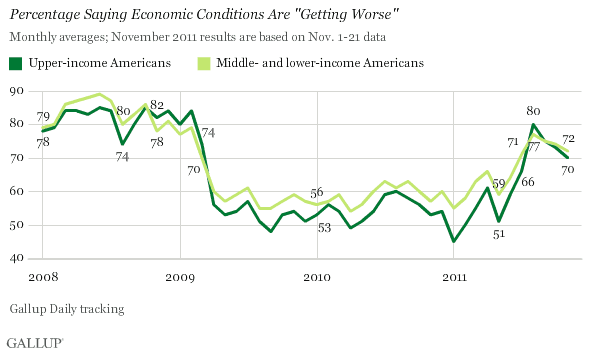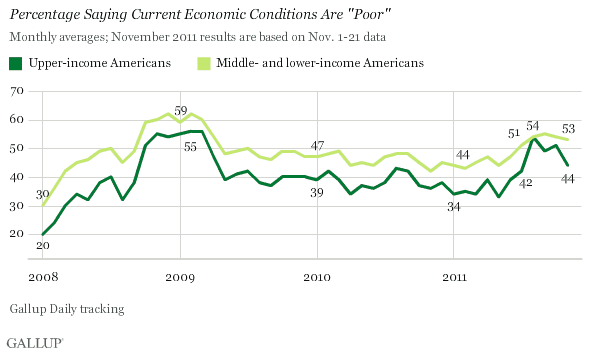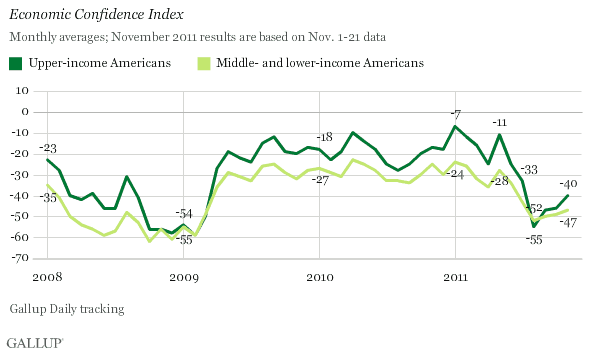PRINCETON, NJ -- Upper-income Americans' economic confidence continued to improve during the first three weeks of November, with 70% saying the economy is "getting worse" -- sharply better than the 80% of August. However, upper-income Americans' negative views of the economy's direction have yet to drop to July's 66%, the level seen just before the end of the budget ceiling battle.

The latest findings in this story reflect an aggregate of Gallup Daily tracking of economic confidence during the first three weeks of November, compared with previous monthly averages.
Upper-income Americans (those with household incomes of at least $90,000 a year) tend to be more optimistic about the future of the economy than those with lower incomes. This situation was reversed in August -- as was the case in late 2008 and early 2009 -- but upper-income Americans are slightly less pessimistic than middle- and lower-income Americans so far in November.
Middle- and lower-income Americans' outlook for the economy has seen similar -- albeit more modest -- improvement during recent months, with 72% so far in November saying the economy is "getting worse." This is better than the 77% of August and essentially as good as July's 71%.
Upper-Income Americans' Ratings of the Economy Improve
Forty-four percent of upper-income Americans rate current economic conditions "poor" so far in November, improved from the 54% of August and almost as good as the 42% of July. August saw the highest percentage providing this rating since March 2009.

Fifty-three percent of middle- and lower-income Americans rate current economic conditions "poor" so far in November, essentially the same as the previous three months. These "poor" ratings are the highest for this group since April 2009.
Gallup's broad Economic Confidence Index, which combines Americans' views on economic conditions now and their expectations, has improved among upper-income Americans so far in November, to -40 from -55 in August, but remains worse than the -33 of July.
The Index also improved -- to -47 -- among middle- and lower-income Americans, from -52 in August. While Economic Confidence Index scores have improved for both income groups since August, those of upper-income Americans have shown relatively greater improvement.

Gallup's Economic Confidence Index has improved to -46 nationally to date in November, up from -52 in August.
Americans' Confidence at Risk
The U.S. economy has improved from the lows seen in August after the debt ceiling debate, and the talk of a double-dip recession has largely abated. While economic confidence has remained depressed, it has shown moderate improvement from the deep recession levels of late 2008 and early 2009.
Upper-income Americans' economic confidence, particularly their optimism about the future direction of the economy, has shown the most improvement. While all Americans have benefited from the recent decline in gas prices at the pump, upper-income Americans have also enjoyed another surge on Wall Street since the August lows. They also may benefit from continued record-low interest rates because they are more likely to qualify for today's cheap credit when they decide to borrow.
One question is whether the stalemate of the congressional supercommittee will send economic confidence -- and upper-income confidence in particular -- plunging to August's low levels. Theoretically, this should not be the case. The failure of the supercommittee simply means the federal budget cuts already legislated will be put into place. These cuts may not please anyone, and could be changed before they become effective in 2013, but for now they remain in place. That is, the failure of the supercommittee has had no real budgetary impact in the short term.
On the other hand, the global markets and the business press may create the perception that this failure means the U.S. government cannot control the federal budget. Talk of a U.S. credit downgrade as a result of the supercommittee stalemate may reinforce this perception. Still, the August lows showed that political confrontation can have a real-world cost in terms of economic confidence. Even though stocks fell on Monday as news spread of the supercommittee's failure, it remains unclear whether the overall impact will match the psychological blow dealt the U.S. economy -- and upper-income Americans in particular -- in August. Confidence could also certainly plummet in the weeks ahead given the financial turmoil in Europe.
Upper-income spending is key to keeping the economy improving, even at its current modest pace. It is also essential to achieving the improvement in holiday sales that American consumers are currently anticipating. It will be unfortunate if the failure of the supercommittee hurts Christmas sales.
Gallup.com reports results from these indexes in daily, weekly, and monthly averages and in Gallup.com stories. Complete trend data are always available to view and export in the following charts:
Daily: Employment, Economic Confidence and Job Creation, Consumer Spending
Weekly: Employment, Economic Confidence, Job Creation, Consumer Spending
Read more about Gallup's economic measures.
View our economic release schedule.
Survey Methods
Results are based on telephone interviews conducted on a monthly basis from January 2008 to October 2011. Each month, Gallup on its Gallup Daily Tracking survey conducts interviews with a random sample of approximately 15,000 adults, aged 18 and older, living in all 50 U.S. states and the District of Columbia. For results based on the total sample of national adults, one can say with 95% confidence that the maximum margin of sampling error is ±3 percentage points.
During the period of Nov. 1-21, 2011, Gallup conducted interviews with a random sample of 9,982 adults, aged 18 and older, living in all 50 U.S. states and the District of Columbia. For results based on the total sample of national adults, one can say with 95% confidence that the maximum margin of sampling error is ±3 percentage points.
Interviews are conducted with respondents on landline telephones and cellular phones, with interviews conducted in Spanish for respondents who are primarily Spanish-speaking. Each sample includes a minimum quota of 400 cell phone respondents and 600 landline respondents per 1,000 national adults, with additional minimum quotas among landline respondents by region. Landline telephone numbers are chosen at random among listed telephone numbers. Cell phone numbers are selected using random-digit-dial methods. Landline respondents are chosen at random within each household on the basis of which member had the most recent birthday.
Samples are weighted by gender, age, race, Hispanic ethnicity, education, region, adults in the household, and phone status (cell phone only/landline only/both, cell phone mostly, and having an unlisted landline number). Demographic weighting targets are based on the March 2010 Current Population Survey figures for the aged 18 and older non-institutionalized population living in U.S. telephone households. All reported margins of sampling error include the computed design effects for weighting and sample design.
In addition to sampling error, question wording and practical difficulties in conducting surveys can introduce error or bias into the findings of public opinion polls.
For more details on Gallup's polling methodology, visit www.gallup.com.
